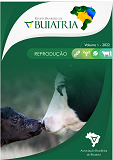A subfertilidade ou infertilidade são afecções que impactam diretamente na produtividade do rebanho e
muitas vezes passam despercebidas pelo produtor. Levando em consideração que mais de 79% das matrizes
bovinas no Brasil ainda são submetidas exclusivamente à monta natural, se torna evidente a importância de
garantir uma alta fertilidade aos touros. Ainda, no cenário brasileiro, apenas 36% dos touros possuem algum
tipo de registro e são efetivamente testados, indicando a pertinência da avaliação andrológica e a difusão de
conhecimento acerca desse tema. Esta técnica se inicia pela anamnese junto ao exame clínico geral, visando
obter o histórico do animal e da propriedade, mostrando um panorama geral sobre o comportamento e
saúde do animal. Em seguida, realiza-se a avaliação clínica voltada prioritariamente ao sistema reprodutivo,
inspecionando a integridade e saúde de todas as estruturas externas e internas relacionadas a este sistema.
Na sequência, realiza-se as provas de comportamento sexual, cujo objetivo é avaliar o interesse pela fêmea e a
capacidade de realizar a monta. Então, após a colheita do sêmen, realiza-se o espermograma para certificação
das características físicas e morfológicas do ejaculado. Finalmente, com base na execução de todas as
etapas, a conclusão da avaliação andrológica é concluída com base na aptidão reprodutiva. Nesta revisão, são
abordadas as etapas para realização do exame andrológico, ressaltando algumas particularidades e as aplicações práticas empregadas na rotina andrológica de touros.
Palavras-chave: avaliação reprodutiva, bovino, colheita de sêmen, espermograma, fertilidade.
Abstract
Subfertility or infertility are conditions that directly impact the productivity of the herd and often go unnoticed
by the producer. Considering that more than 79% of Brazilian bovine females are still subjected exclusively
to natural breeding, the importance of certifying high fertility for bulls becomes evident. In the Brazilian
scenario, only 36% of bulls have some type of registration and are effectively tested, indicating the
relevance of andrological examination and the dissemination of knowledge on this topic. is technique
begins with anamnesis along with the general clinical examination, aiming to obtain the history of the animal
and the property, showing a general overview of the animal's behavior and health. Next, a clinical examination
is conducted, focusing primarily on the reproductive system, inspecting the integrity and health of
all external and internal structures related to this system. Sexual behavior tests are conducted, the aim of
which is to assess interest in the female and the ability to mount. en, after collecting the semen, a
spermogram is performed to certify the physical and morphological characteristics of the ejaculate. Finally,
based on the execution of all steps, the andrological evaluation is completed based on reproductive capability.
In this study, a review of the steps for carrying out the andrological examination is discussed, highlighting
some particularities and practical applications used in the andrological routine of bulls.
Keywords: reproductive evaluation, bovine, semen collection, spermogram, fertility.


